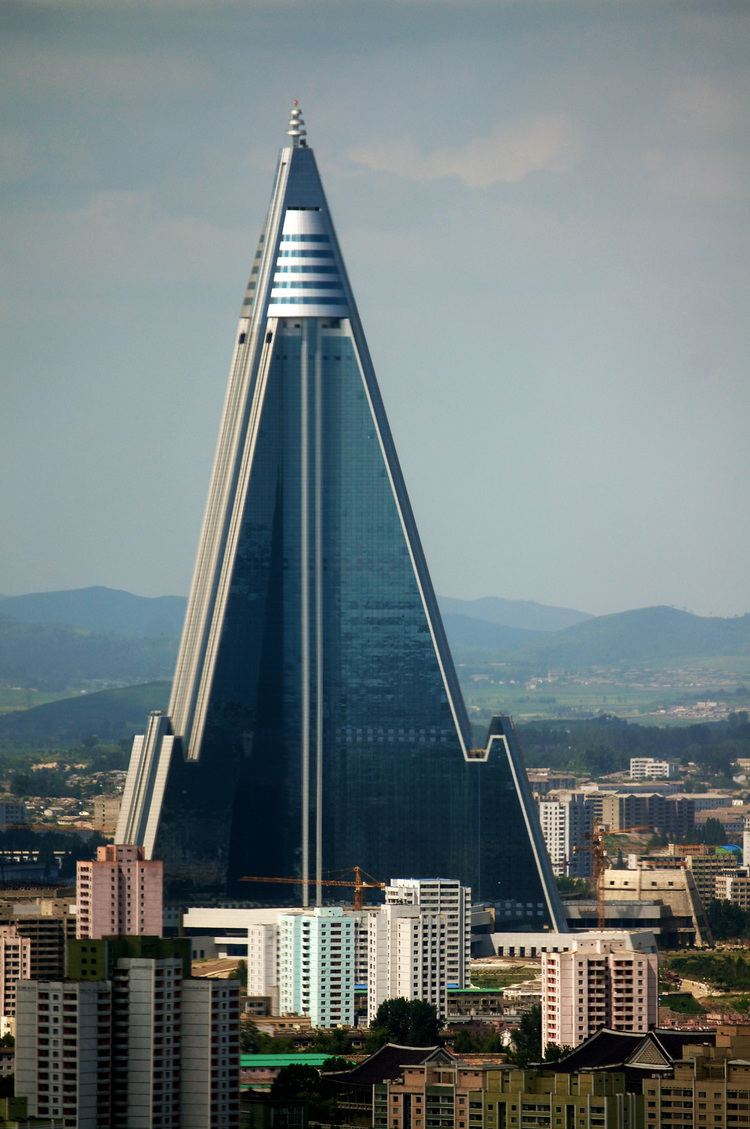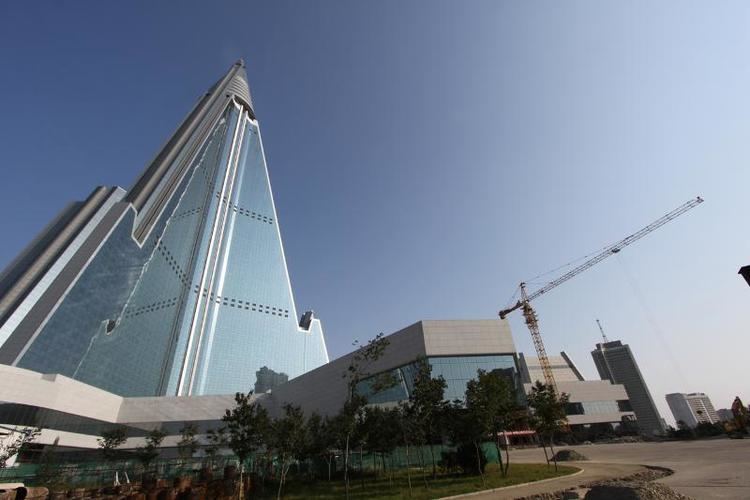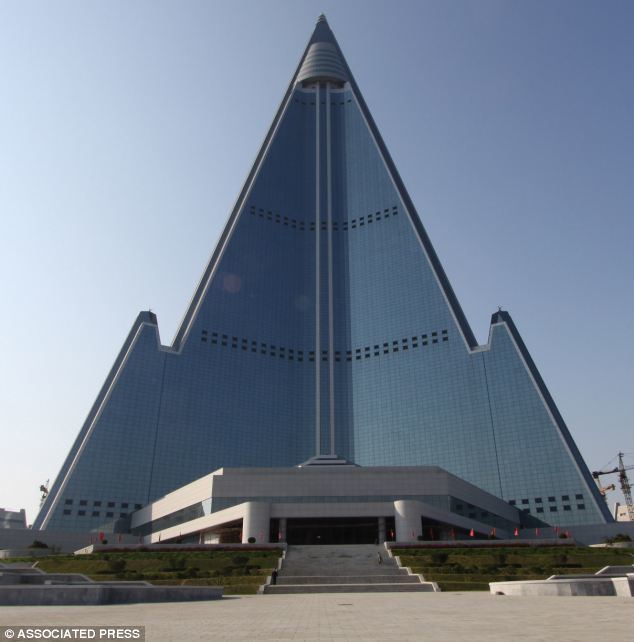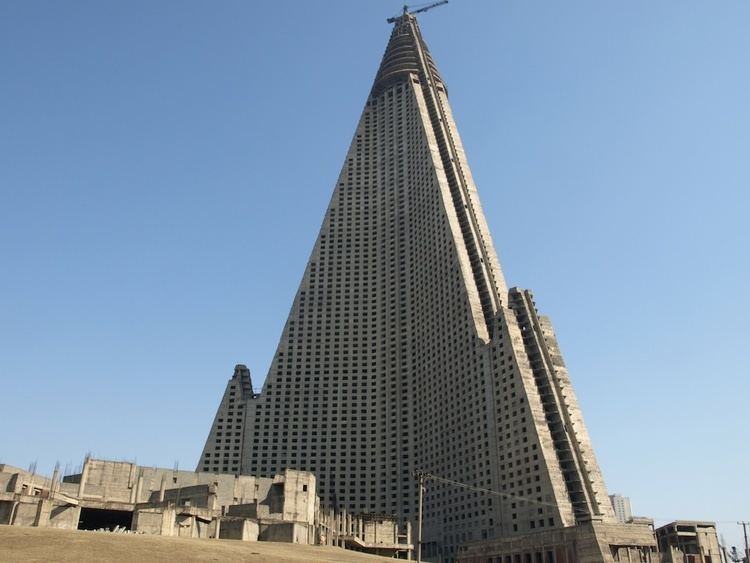Status Topped-out Topped-out 1992 Floor count 105 Construction started 1987 Architectural style Modern architecture | Estimated completion Unknown Height 330 m Floors 105 Owner Orascom Group | |
 | ||
Roof 330.02 metres (1,082.7 ft) Architecture firm Baikdoosan Architects & Engineers Similar Yanggakdo International Hotel, Juche Tower, Rose Tower, Kumsusan Palace of the Sun, Rungrado 1st of May Stadium | ||
Ryugyong hotel
The Ryugyong Hotel (Chosŏn'gŭl: 류경려관; sometimes anglicised as Ryu-Gyong Hotel or Yu-Kyung Hotel) is an unfinished 105-story, 330 metres (1,080 ft) tall pyramid-shaped skyscraper in Pyongyang, North Korea. Its name ("capital of willows") is also one of the historical names for Pyongyang. The building is also known as the 105 Building, a reference to its number of floors. The building has been planned as a mixed-use development, which would include a hotel.
Contents
- Ryugyong hotel
- A tour of the ryugyong hotel in pyongyang
- Architecture
- Start
- First halt
- Second start
- Second halt
- References

Construction began in 1987 but was halted in 1992 as North Korea entered a period of economic crisis after the fall of the Soviet Union. After 1992 the building stood topped out, but without any windows or interior fittings. In 2008 construction resumed, and the exterior was completed in 2011. It was planned to open the hotel in 2012, the centenary of Kim Il-sung's birth, but this did not happen. A partial opening was announced for 2013, but this was also cancelled. As of 2017, the building remains unopened.

A tour of the ryugyong hotel in pyongyang
Architecture

The Ryugyong Hotel is 330 metres (1,080 ft) tall, making it the most prominent feature of Pyongyang's skyline and by far the tallest structure in North Korea. Construction of the Ryugyong Hotel was intended to be completed in time for the 13th World Festival of Youth and Students in June 1989; had this been achieved, it would have held the title of world's tallest hotel. The unfinished building was not surpassed in height by any new hotel until the 2009 completion of the spire atop the Rose Tower in Dubai, United Arab Emirates. The Ryugyong Hotel is the world's 63rd tallest building (tied with the China World Trade Center Tower III, Zhuhai St. Regis Hotel & Office Tower, and Yuexiu Fortune Center l in height) and has the tenth most floors. It is also the tallest unoccupied building in the world.

The building consists of three wings, each measuring 100 metres (330 ft) long, 18 metres (59 ft) wide, and sloped at a 75‑degree angle, which converge at a common point to form a pinnacle. The building is topped by a truncated cone 40 metres (130 ft) wide, consisting of eight floors that are intended to rotate, topped by a further six static floors. The structure was originally intended to house five revolving restaurants, and either 3,000 or 7,665 guest rooms, according to different sources. According to Orascom's Khaled Bichara in 2009, the Ryugyong will not be just a hotel, but rather a mixed-use development, including "revolving restaurant" facilities along with a "mixture of hotel accommodation, apartments and business facilities".
Start
The plan for a large hotel was reportedly a Cold War response to the completion of the world's tallest hotel, the Westin Stamford Hotel in Singapore, in 1986 by the South Korean company SsangYong Group. North Korean leadership envisioned the project as a channel for Western investors to step into the marketplace. A firm, the Ryugyong Hotel Investment and Management, was established to attract a hoped-for $230 million in foreign investment. A representative for the North Korean government promised relaxed oversight, allowing "foreign investors [to] operate casinos, nightclubs or Japanese lounges". North Korean construction firm Baikdoosan Architects & Engineers (also known as Baekdu Mountain Architects and Engineers) began construction on a pyramid‑shaped hotel in 1987.
First halt

The hotel was scheduled to open in June 1989 for the 13th World Festival of Youth and Students, but problems with building methods and materials delayed completion. Had it opened on schedule, it would have surpassed the Westin Stamford Hotel to become the world's tallest hotel, and would have been the seventh-tallest building in the world.
In 1992, after the building had reached its full architectural height, work was halted due to the economic crisis in North Korea following the collapse of the Soviet bloc. Japanese newspapers estimated the cost of construction was $750 million, consuming 2 percent of North Korea’s GDP. For over a decade, the unfinished building sat vacant and without windows, fixtures, or fittings, appearing as a massive concrete shell. A rusting construction crane remained at the top, which the BBC called "a reminder of the totalitarian state's thwarted ambition". According to Marcus Noland, in the late 1990s, the European Union Chamber of Commerce in Korea inspected the building and concluded that the structure was irreparable. Questions were raised regarding the quality of the building's concrete and the alignment of its elevator shafts, which some sources said were "crooked".
In a 2006 article, ABC News questioned whether North Korea had sufficient raw materials or energy for such a massive project. A North Korean government official told the Los Angeles Times in 2008 that construction was not completed "because [North Korea] ran out of money".
The halt in construction, the rumours of problems and the mystery about its future led foreign media sources to dub it "the worst building in the world", "Hotel of Doom" and "Phantom Hotel".
Second start
In April 2008, after 16 years of inactivity, work on the building was restarted by the Egyptian company Orascom Group. The firm, which had entered into a US$400 million deal with the North Korean government to build and run a 3G mobile phone network, said that their telecommunications deal was not directly related to the Ryugyong Hotel work. In 2008 North Korean officials stated that the hotel would be completed by 2012, coinciding with the 100th anniversary of the birth of the "Eternal President", Kim Il-sung. In 2009, Orascom's Chief Operating Officer Khaled Bichara noted that they "had not had too many problems" resolving the reported structural issues of the building, and that a revolving restaurant will be located at the top of the building.
In July 2011, it was reported that the exterior work was complete. Features that Orascom has installed include exterior glass panels and telecommunications antennas. In 2012, photographs taken by Koryo Tours were released, showing the interior for the first time. There were few fixtures or furnishings. In November 2012, international hotel operator Kempinski announced it would be running the hotel which was expected to partially open in mid‑2013.
Second halt
In March 2013, plans to reopen the hotel were suspended. Kempinski clarified its earlier statements saying that only “initial discussions” had ever occurred, but that no agreement had been signed because “market entry is not currently possible”. Kempinski gave no reasons, but commentators suggested that international tensions related to the 2013 North Korean nuclear test, economic risks, and delays in construction probably played a part.
